
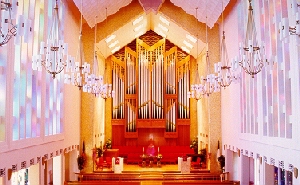
Flue Pipe Construction |
Metal Flue Introduction |
Metal Flue Bodies |
Metal Flue Mouths
Wooden Flue Introduction |
Wooden Flue Bodies |
Wooden Flue Mouths


Flue Pipe Construction |
Metal Flue Introduction |
Metal Flue Bodies |
Metal Flue Mouths
Wooden Flue Introduction |
Wooden Flue Bodies |
Wooden Flue Mouths
 Flue pipes (usually
called simply "flues") have no moving parts. Their sound is produced when
a stream
of air is focused onto a sharp edge - - the upper lip of a flue pipe. As the wind
strikes the lip, its
smooth flow is disturbed. In the resulting disturbance, a vibration is set up in the
air column
contained in the pipe body, producing an audible sound wave. A similar structure and
result can
be seen in the mouth of a recorder, which produces its sounds in the same way.
Flue pipes (usually
called simply "flues") have no moving parts. Their sound is produced when
a stream
of air is focused onto a sharp edge - - the upper lip of a flue pipe. As the wind
strikes the lip, its
smooth flow is disturbed. In the resulting disturbance, a vibration is set up in the
air column
contained in the pipe body, producing an audible sound wave. A similar structure and
result can
be seen in the mouth of a recorder, which produces its sounds in the same way.
Flue pipes have two primary parts, the foot and the body. Although
these names are used for both metal and wooden flues, there are other differences in
their
construction, according to the material being used. These differences are examined in
detail
below.
The body of metal flues is typically circular in horizontal cross section, and it may be either cylindrical or conical in shape. The top of the body may be either open, closed or partially closed.
 When the pipe is open, the
end may be
treated in one of several ways. The first method is to cut the pipe to the correct
length to obtain
the desired pitch. Because changes in temperature and the density of the surrounding
air can have
an effect on pitch, these pipes may be altered slightly by having the edges turned
slightly out, or
slightly in to modify the pitch. This approach to pitch modification is called
coning or cone tuning, and must be done very carefully. The photograph
shows
two pipes from a 2' Principal that have been coned in opposite ways.11
When the pipe is open, the
end may be
treated in one of several ways. The first method is to cut the pipe to the correct
length to obtain
the desired pitch. Because changes in temperature and the density of the surrounding
air can have
an effect on pitch, these pipes may be altered slightly by having the edges turned
slightly out, or
slightly in to modify the pitch. This approach to pitch modification is called
coning or cone tuning, and must be done very carefully. The photograph
shows
two pipes from a 2' Principal that have been coned in opposite ways.11
 The second treatment for the
top of a flue
pipe is to fit the open end with a movable sleeve or collar of metal. The
collar is not
fastened to the body of the pipe, but is held tightly in place by tension, leaving it
free to be moved
up or down to affect pitch changes. Even when the pipe is made of spotted metal, a
thinner, less
malleable sheet of metal is used for the collar, as seen in this photograph.
12
The second treatment for the
top of a flue
pipe is to fit the open end with a movable sleeve or collar of metal. The
collar is not
fastened to the body of the pipe, but is held tightly in place by tension, leaving it
free to be moved
up or down to affect pitch changes. Even when the pipe is made of spotted metal, a
thinner, less
malleable sheet of metal is used for the collar, as seen in this photograph.
12
 Finally, open pipes may have
two small cuts
made into the material of the body at the open end. The metal between the cuts may
be rolled
down to shorten the effective length of the body, as seen in the photograph to the
right. 13
The resulting curl of metal is usually called the "scroll," and the process of tuning
a pipe in this
manner is referred to as "scroll tuning" or "scrolling."
Alternately a separate, movable piece of metal can be fastened to the body of the
pipe. This can
then be moved up or down to make a similar change.
Finally, open pipes may have
two small cuts
made into the material of the body at the open end. The metal between the cuts may
be rolled
down to shorten the effective length of the body, as seen in the photograph to the
right. 13
The resulting curl of metal is usually called the "scroll," and the process of tuning
a pipe in this
manner is referred to as "scroll tuning" or "scrolling."
Alternately a separate, movable piece of metal can be fastened to the body of the
pipe. This can
then be moved up or down to make a similar change.
 When a metal pipe is closed at
the top, it is
usually fitted with a cap, which is slightly larger in diameter than the pipe
and fits over the
end. The inner rim of the cap is usually lined with felt, so that air pressure will
not cause a rattle,
and the felt is often folded over the outer rim of the cap and is visible. Closed
metal pipes can
often be recognized by the presence of a felt band marking the end of the cap, as
seen in this
photograph.
14
When a metal pipe is closed at
the top, it is
usually fitted with a cap, which is slightly larger in diameter than the pipe
and fits over the
end. The inner rim of the cap is usually lined with felt, so that air pressure will
not cause a rattle,
and the felt is often folded over the outer rim of the cap and is visible. Closed
metal pipes can
often be recognized by the presence of a felt band marking the end of the cap, as
seen in this
photograph.
14
 Two types of partially closed
metal pipes are common. In the form seen at the right, an opening in the cap is
extended by a
smaller metal cylinder.
16 In some cases the cylinder is
extended downwards into the body of the
pipe. Pipes made like this are called in different languages Chimney flute,
Rohrflöte,
or Flûte à cheminée in description of their appearance.
Two types of partially closed
metal pipes are common. In the form seen at the right, an opening in the cap is
extended by a
smaller metal cylinder.
16 In some cases the cylinder is
extended downwards into the body of the
pipe. Pipes made like this are called in different languages Chimney flute,
Rohrflöte,
or Flûte à cheminée in description of their appearance.
 Alternately, the cap itself may
be
made in a
conical shape with an opening at the smaller end of the cone. The photograph to the
left shows the conical
cap of a Koppelflöte with the opening visible in its top.
17 A Spillflöte has
a
cap with a similar, more elongated shape.
Alternately, the cap itself may
be
made in a
conical shape with an opening at the smaller end of the cone. The photograph to the
left shows the conical
cap of a Koppelflöte with the opening visible in its top.
17 A Spillflöte has
a
cap with a similar, more elongated shape.
 Although most flues - - whether
the bodies are made of wood or metal, or whether they are
cylindrical or conical - - are straight, their bodies may in fact be mitered,
or bent at one or
more angles. These changes in the shape of the body are made only when space or
other
limitations must be considered. Mitering a pipe has only a small effect on the
quality of the sound,
but the change of direction in an open pipe can cause the projection of the sound to
be different.
In metal pipes, like the one in the photograph to the right, mitering can lead to
instability in the
body. If a soft metal is used (one with high lead content, for example), extra
support must be
provided or the pipe can be pulled apart by its own weight. The pipe in the
photograph is made of
zinc and is stable.
15
Although most flues - - whether
the bodies are made of wood or metal, or whether they are
cylindrical or conical - - are straight, their bodies may in fact be mitered,
or bent at one or
more angles. These changes in the shape of the body are made only when space or
other
limitations must be considered. Mitering a pipe has only a small effect on the
quality of the sound,
but the change of direction in an open pipe can cause the projection of the sound to
be different.
In metal pipes, like the one in the photograph to the right, mitering can lead to
instability in the
body. If a soft metal is used (one with high lead content, for example), extra
support must be
provided or the pipe can be pulled apart by its own weight. The pipe in the
photograph is made of
zinc and is stable.
15
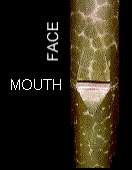 In metal pipes the foot is
usually conical and expands from a small base to the point at which it joins the
body. An inset
plane around the joint between foot and body is called the face, and an
opening into the
pipe - - the mouth - - is cut into the pipe on that plane above the
languid, an
internal horizontal plate that almost completely closes off the foot from the body.
In metal pipes the foot is
usually conical and expands from a small base to the point at which it joins the
body. An inset
plane around the joint between foot and body is called the face, and an
opening into the
pipe - - the mouth - - is cut into the pipe on that plane above the
languid, an
internal horizontal plate that almost completely closes off the foot from the body.
 Wind enters the pipe through
the toe, appropriately located at the base of the foot, and exits the foot
through the
flue, a narrow opening between the languid and the lower lip. These
two parts
focus the wind onto a relatively sharp edge called the upper lip.
Wind enters the pipe through
the toe, appropriately located at the base of the foot, and exits the foot
through the
flue, a narrow opening between the languid and the lower lip. These
two parts
focus the wind onto a relatively sharp edge called the upper lip.
A pipe mouth may have two additions made externally.
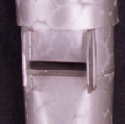 Ears
are vertical metal plates attached at the left and right of the mouth. They aid in
focusing the wind onto the upper lip. The pipe in the photograph to the right is a
small
Koppelflöte; the cap extends downward to the top of the ears.
23
Ears
are vertical metal plates attached at the left and right of the mouth. They aid in
focusing the wind onto the upper lip. The pipe in the photograph to the right is a
small
Koppelflöte; the cap extends downward to the top of the ears.
23
 A harmonic bridge,
commonly called a beard, is a horizontal plate attached below the lower
lip, or a
wooden
dowel placed between the ears. The photograph to the left shows a pipe mouth with
ears and a
wooden bridge.
24
A harmonic bridge,
commonly called a beard, is a horizontal plate attached below the lower
lip, or a
wooden
dowel placed between the ears. The photograph to the left shows a pipe mouth with
ears and a
wooden bridge.
24
 The choice of
materials has an effect on the shape a pipe assumes, and wooden pipes are most often
square or
rectangular in horizontal cross section. As the photograph to the left shows, even
wooden pipes
usually have a cylindrical extension at their base, and that extension will often
terminate in a lead
tip which allows the toe hole to be opened or closed without damage to the wood.
25
The choice of
materials has an effect on the shape a pipe assumes, and wooden pipes are most often
square or
rectangular in horizontal cross section. As the photograph to the left shows, even
wooden pipes
usually have a cylindrical extension at their base, and that extension will often
terminate in a lead
tip which allows the toe hole to be opened or closed without damage to the wood.
25
Two exceptions to wooden pipes having a rectangular shape are noteworthy:
The body of a wooden flue may be either open, closed or partially closed, but the construction of the upper end of wooden pipe bodies is different from that found in metal pipes.
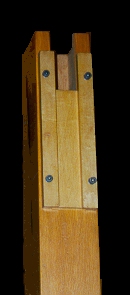 Open wooden bodies
cannot be
cone tuned, as can metal ones, because wood cannot be flared or coned inward to
effect a pitch
change without destroying the material. Sliding tuning collars are also not found on
wooden
pipes. They are instead fitted with a slot and a movable wooden slide that can be
used to change
the effective resonating length of the body.
26
Open wooden bodies
cannot be
cone tuned, as can metal ones, because wood cannot be flared or coned inward to
effect a pitch
change without destroying the material. Sliding tuning collars are also not found on
wooden
pipes. They are instead fitted with a slot and a movable wooden slide that can be
used to change
the effective resonating length of the body.
26
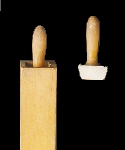 Closed wooden bodies are
usually fitted with a stopper made of wood and padded with leather. The
stopper is made
to fit inside the body and usually has a handle, or even a cord, attached to its top
so that its depth
can be adjusted. The photograph shows a typical stopped pipe with a stopper from
another pipe
beside it.
27
Closed wooden bodies are
usually fitted with a stopper made of wood and padded with leather. The
stopper is made
to fit inside the body and usually has a handle, or even a cord, attached to its top
so that its depth
can be adjusted. The photograph shows a typical stopped pipe with a stopper from
another pipe
beside it.
27
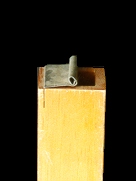 Partially closed wooden
pipes
are made in several different ways. The most common way is found when a piece of
metal is
attached to one side of the top of a wooden body. The flap of metal is then rolled
back, or
scrolled, to partially uncover the top of the pipe.
28
Partially closed wooden
pipes
are made in several different ways. The most common way is found when a piece of
metal is
attached to one side of the top of a wooden body. The flap of metal is then rolled
back, or
scrolled, to partially uncover the top of the pipe.
28
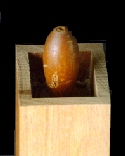 A less
common means of
partially
closing a wooden pipe is found in the case of wooden Chimney flutes. In these pipes,
which are
much less common than metal Chimney flutes, a hole is bored through the wooden handle
of the
stopper. The wooden Rohrflöte shown in the photograph to the left has been made
by
fitting a new wooden Gedeckt with stoppers from an older pipe.
29
A less
common means of
partially
closing a wooden pipe is found in the case of wooden Chimney flutes. In these pipes,
which are
much less common than metal Chimney flutes, a hole is bored through the wooden handle
of the
stopper. The wooden Rohrflöte shown in the photograph to the left has been made
by
fitting a new wooden Gedeckt with stoppers from an older pipe.
29
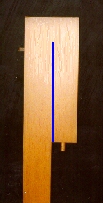 The body of a wooden pipe by
be mitered, or turned at an angle. Particularly in the case of stopped pipes, there
is no change in
the projection of sound, because the mouth, through which the sound is heard in a
stopped pipe,
can have the same placement as unmitered pipes in the same rank. If a miter is
extensive, a
wooden pipe can become unstable without support, as can a metal pipe. The photograph
to the
right shows one way of building a wooden mitered pipe so that there is little
possibility for
instability. The side of the pipe uses one piece of wood for both sections of the
miter. A blue line
shows the internal wall that separates the two sections, so that the body consists of
one resonating
space that has been folded over and covered with one piece of wood.
30
The body of a wooden pipe by
be mitered, or turned at an angle. Particularly in the case of stopped pipes, there
is no change in
the projection of sound, because the mouth, through which the sound is heard in a
stopped pipe,
can have the same placement as unmitered pipes in the same rank. If a miter is
extensive, a
wooden pipe can become unstable without support, as can a metal pipe. The photograph
to the
right shows one way of building a wooden mitered pipe so that there is little
possibility for
instability. The side of the pipe uses one piece of wood for both sections of the
miter. A blue line
shows the internal wall that separates the two sections, so that the body consists of
one resonating
space that has been folded over and covered with one piece of wood.
30
The mouths of wooden pipes are generally built as a part of the body. The languid is replaced by the block, a piece of wood that is as wide as the interior dimension of the pipe body. This block of wood has a cylindrical hole drilled in its lower surface, through which the cylindrical foot is attached. Another hole is bored from the front of the block, intersecting the space made be the first hole. A small plate of wood, called the face, is attached to the front of the block. The face has a small amount of material removed from the side that will be in contact with the block. The small space fits over the hole so that wind can enter it. The wind then moves through the space between block and face and exits through the flue formed by the top of the face and the block.
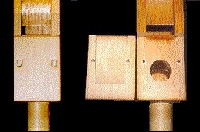 The photograph at the left
shows two views of the mouth of a wooden
pipe. In the first view, the mouth appears as it normally does in a working pipe.
In the second,
the face has been removed and turned over to show its back side. The shallow cut,
which covers
most of the area of the plate, is visible on the face.
31
The photograph at the left
shows two views of the mouth of a wooden
pipe. In the first view, the mouth appears as it normally does in a working pipe.
In the second,
the face has been removed and turned over to show its back side. The shallow cut,
which covers
most of the area of the plate, is visible on the face.
31
© 1998, James H. Cook